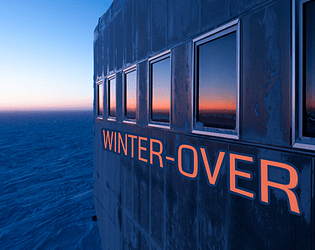my creation by dino is a short (10 minutes) parser game (the IFComp website incorrectly said it was Twine but I have emailed them about this) in which the PC is a dad stuck in bed in a rickety house with his crying baby. You would never guess this from the cover art, a design which will only resonate if you complete the game.
Endlessly crying babies raise human hackles at a primordial level, so the game's temporal depiction of that common experience of shuffling around a room one can't leave while the crying can't be stopped is likely to knife (or knife anew) anyone who tries it, in spite of major implementation gaps. It's clear my creation hasn't had a testing round or received any technical advice, but I commend the author for bringing a story like this to the parser format on their own. Other gains can come in future.
It's important to say there's ultimately more to the game than the screaming baby. If that had been the whole thing, it would be an uninviting ask of players to say the least. It's tough as is. But there is more. I will discuss the more with complete spoilering in the remainder of the review.
The PC's in the bed and the baby's in a nearby basket, crying. Where the geography of the parser model really works for this game is making the bed into the PC's world. For reasons not made clear until the end, the prose indicates the PC is in physical pain and inhibited in movement, so each NORTH, SOUTH etc. drags them, with effort, to another section of the bed. The efforts are described. On the one hand, the idea of thinking about compass directions while moving around a bed is absurd. Obviously we're not meant to be thinking about them, they're just the stock method of movement in a parser game. For a new author to program up some replacement terminology would be a big ask, so in this case, it shows dino working with the strengths of the format, but also the need to bend the format's stock trappings to the game. In prose, it's also effective for the bed world that the game's opening paragraph is written in the third person (the rest of the game is in typical parser second person) offering a bird's eye view of the situation:
"He is lying in his bed, in his bedroom, in his own crooked little house with small windows, single glass, overlooking other crooked houses;"
The cut from this intro text into the "middle of the bed" location, the change of scale and pronoun and person, all act together like a magnifying glass zooming in on the PC's situation, where suddenly one bed seems giant.
The geography of the bed isn't respected in the programming, though. There's a constant mismatch between what's described, what can be acted on, where things are. This doesn't block progress – the game is too small for that – but it does interrupt the spell of the fiction and so reduce its power. One inadvertent side-effect was that I was chuckling at my gauche handling of such props as the baby or the basket, but at the same time I experienced a kind of remote terror in handling them. Like, god, I hope the game won't let me DROP the baby in any bad way.
I was surprised when, having found a copy of the novel Frankenstein near the bed, I typed READ BOOK and was suddenly hit with an almost 700-word excerpt. This moment broke the dirge of the baby situation and made me re-engage afresh. I also admit that my kneejerk reaction to the idea of reading Frankenstein to a baby was laughter, but I remembered a second later, of course you can read anything to a baby with a chance of soothing the baby. Reading Frankenstein to this baby is the "winning move". It leads to another text block, this one almost 800 words, in which the dad monologues to the restful baby.
The monologue drops the details of the story into place. It's not a twist, but narratively it has some of the functions of a twist of a short story. The dad's in pain in bed because he's had gender-changing surgery, but before that he gave birth to the child. The monologue muses on their possible future and their future relationship. It's certainly a breather after the oppression of game-long crying, and the dewy-eyed intimacy of the moment feels real. In the context of what's come before, which gave away little, and only a little bit at a time, 800 words straight up inevitably feels expositional. That's how I/we typically respond to story structures and lengths after we've encountered enough of them. But the monologue doesn't feel expositional in a "nobody would say all this" kind of way, and I think that's more important. It reads authentic and illuminates the sketched character of the dad. The value of Frankenstein is now also apparent, its tale of human creation and unusual birth and an outsider human in an unusual body resonant with the PC's experiences.
I valued my creation more after playing it and after thinking about it than during the playing, at which time the implementation was kicking the atmosphere every few moves. Even implementation can't stop a baby crying baby, though.






